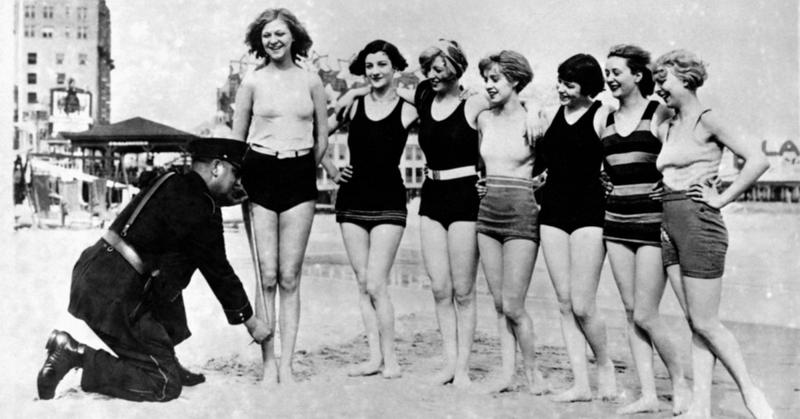Bikini Laws: When Women Could Be Arrested For Wearing The Wrong Swimsuit
By | November 14, 2020

We've come a long way, baby. Considering all the barely there string bikinis on display at every public beach and pool these days, it's hard to imagine there was once a time when communities were so concerned about the attire of bathing beauties that they passed bikini laws and employed officials to monitor the swimsuits of local beachgoers. Violators could be sent home, forced to cover up, fined, or even arrested.
The Swimsuit Police
Women once wore stockings and floor-length gowns with long sleeves and high necklines to take a dip, which must have been wildly uncomfortable. That's probably why they started getting shorter and shorter in the early 1900s, and by the 1920s, they were positively scandalous, revealing bare shoulders and knees. Knees, for Pete's sake.
Something had to be done before America fell into irretrievable debauchery, so many municipalities passed laws enforcing the length of swimsuits, often prohibiting anything shorter than six inches above the knee. Swimsuit police were employed to make sure swimmers didn't break the rules, and if they found a woman with a swimsuit that was too short, she was either sent home to change or forced to cover up. Beach police in Chicago found a clever method of ensuring that patrons maintained their modesty: a "beach tailor" who could be summoned to sew up oversize armholes or affix a layer of fabric to the bottoms of skirts deemed too short or the tops of necklines deemed too low.

Arrested For Athleticism
The swimwear that women were permitted to wear was bulky and cumbersome, which was a make-or-break issue for competitive swimmers. Swimmers in Australia, where the sport has long been a favorite, remedied the problem by developing bathing suits for women that were modest yet allowed free range of motion. When one such swimmer, Annette Kellerman, arrived in the U.S. in 1907 and visited a Boston beach wearing one of these athletic swimsuits, she was arrested for indecent exposure.
Kellerman successfully argued in court that she was hindered from practicing her sport by the modesty laws of the U.S. and advocated for the right to swimwear that allowed women to move freely in the water. She even released her own line of swimwear to ease women in the U.S. toward modern designs.

The True Bikini
Swimwear became shorter and sleeveless in the 1920s and 1930s, but this still wasn't enough for many women. Coco Chanel had popularized a sun-kissed complexion, leading fashionistas to discreetly hike up their skirts and push down their sleeves to achieve a more even tan. French engineer Louis Reard took notice and designed a swimsuit to meet their needs, introducing the world to his bikini swimsuit in 1946.
The revealing two-piece suit caused quite a stir. Women in Europe embraced the sexy and modern bikini, but for American women, the trend was slow to catch on. Ursula Andress is credited with igniting the bikini craze in the U.S. after her appearance in the 1962 James Bond film Dr. No. With so many women rushing out to buy their own bikini—and with the women's liberation movement in full swing—bikini laws were finally relaxed on American beaches.

Modesty For Men
Women weren't the only ones whose beachwear was policed. On the grounds that no one wanted to see "gorillas on the beaches," the city council of Atlantic City, New Jersey passed laws mandating shirts at the shore, and beaches around the country followed suit. Men who went topless could be fined and forced to put their shirts back on, but starting in 1937, many of these local rules were overturned and men could once again enjoy the sunshine on their bare chests.

